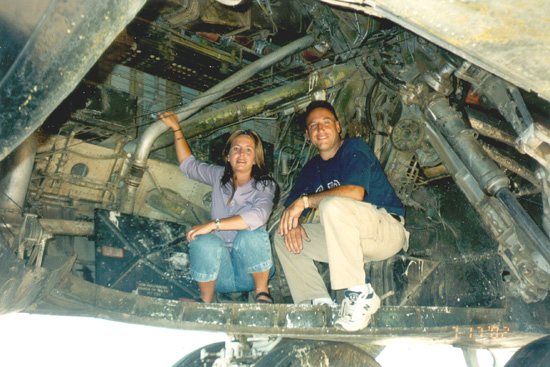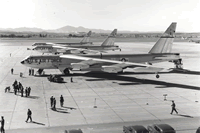
Inside the Wheel Well of a B-52 Stratofortress

Stratofortress Finds Records Made to be Broken
Almost from the start of its operational service, the B-52 proved to be a record-breaking aircraft. Time and again the B-52 demonstrated its speed, range, payload-carrying capability and endurance. These spectacular flights served as dramatic testimony that the Stratofortress could carry out its mission and reach any target on the globe, a mission it flew in actual combat in 1991 during Operation Desert Storm.
Other record-breaking flights include these:
Nov. 25, 1956
Operation Quick Kick: Four B-52Bs of the 93rd Bomb Wing and four B-52Cs
of the 42nd Bomb Wing completed a 16,000-mile nonstop flight around the
perimeter of North America. The flight required four in-flight refuelings and
included a pass over the North Pole.
 Jan.
16, 1957
Jan.
16, 1957
Three B-52Bs of the 93rd Bomb Wing flew nonstop around the world. With the help
of several in-flight refuelings, the bombers covered the 24,325-mile route in 45
hours and 19 minutes, cutting in half the previous record. Average speed was 530
mph.
Nov. 17, 1957
Six B-52s flew nonstop from the United States to Buenos Aires, Argentina, and
back. Average speed for the 10,600-mile flight was 560 mph. This was the first
time B-52 jet bombers teamed up with the Boeing KC-135 jet tankers for an actual
long-range refueling mission.
Jan. 11, 1962
A B-52H set a new straight-line distance record by completing a nonstop,
unrefueled flight from Okinawa, Japan, to Madrid, Spain. The aircraft was flown
by a 15th Air Force crew from the 4136th Strategic Wing based at Minot Air Force
Base, North Dakota. The flight lasted 21 hours and 52 minutes and covered 12,519
miles.
Nov. 1, 1963
In a test flight with a Boeing Wichita crew, a B-52H remained in the air for 26
hours and 26 minutes as it flew 12,400 miles over the entire outline of the
continental United States. At the time, the flight was the longest by a Boeing
crew. The purpose of the test flight was to provide data on loads and stress
exerted on the aircraft during high-altitude, long-endurance missions.
Jan. 16, 1991
Operation Desert Storm: Air operations in the Gulf War began when seven
B-52Gs took off from Barksdale Air Force Base, Louisiana, and headed for Iraq.
After hitting their targets, the B-52s returned to Barksdale. The flight covered
more than 14,000 miles with the planes remaining in the air for 35 hours, making
it the longest air-combat mission in history at that time.
April 11, 2002